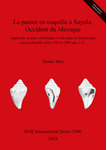La parure en coquille à Sayula, Occident du Mexique
Approche techno-stylistique et role dans la dynamique socioculturelle entre 450 et 1000 apr. J.-C. - S2900
- Anno: 2018
- Autore/i: Elodie Mas
- Catalogo: BAR British Archaeological Reports
- Argomento: Archeologia
- ISBN: 9781407316239
- ISSN:
Entre 450 et 1000 apr. J.-C., les coquilles jouent un rôle fondamental dans les dynamiques socioéconomiques et culturelles des populations installées dans le bassin de Sayula. La présence d’un grand nombre d’indices de manufacture offre des données inédites sur l’exploitation des ressources marines pour la fabrication de parures. Une analyse systématique du matériel est menée, prenant en compte trois aspects: taxonomique, typologique et technologique. Les traces techniques, macro et microscopiques, sont observées ; le travail est complété par l’analyse de micrographies (Microscope Electronique à Balayage) et par la mise en place d’un protocole expérimental. Un modèle de classification des pièces en fonction de leur degré de transformation est établi (matière première, ébauche, préforme, déchet, objet fini, etc.), ce qui permet de déterminer leur place au sein de la chaîne opératoire (préparation, débitage, façonnage, finition). Cette recherche contribue à une meilleure compréhension des comportements techniques des artisans préhispaniques, ainsi que des mécanismes de production des économies passées.
Between 450 and 1000 AD, seashells played a fundamental role in the socioeconomic and cultural dynamics of the populations living in the region of the Sayula Basin. The study of the exploitation of marine resources used to manufacture seashell adornments provides new data stemming from the large number of technical products. Mas has here carried out a detailed and systematic description of the malacological remains, from three analytical perspectives: taxonomic, typological and technological. The book includes a description of adornments’ technical traces, based on macroscopic, microscopic and micrographic observations (using a Scanning Electron Microscope) which is complemented with experimental protocols. The work establishes a model for the classification of each artifact according to its degree of transformation (such as blank, roughout, preform, debris, finished object, etc.) and thus determines its place in the operational sequence (the treatment of the raw material, the débitage, the shaping, and the finishing process). This research offers insights into the behaviour of pre-Hispanic craftsmen, and contributes towards an understanding of the mechanisms of past economies.
AUTHOR
Elodie Mas est docteur en archéologie de l’Université Paris 1, Panthéon-Sorbonne. En 2016, sa thèse reçoit le prix Alfonso Caso (INAH, Mexique) qui récompense les meilleurs travaux en archéologie. Spécialiste en analyses technologiques de matériel malacologique, ses travaux lui permettent d’aborder les comportements techniques des artisans préhispaniques.
Elodie Mas holds a doctorate in archaeology from the Pantheon-Sorbonne University in Paris. In 2016, her thesis was awarded the Alfonso Caso Award (INAH, Mexico) for academic excellence in archaeology. Mas is a specialist in the technological analysis of malacological remains, and her work offers insights into the behaviours of pre-Hispanic craftsmen.
F.to 21x29,7, 420 pages, Illustrated throughout in colour and black and white. 322 figures (64 in colour). With additional material online (Appendices and Figures)



